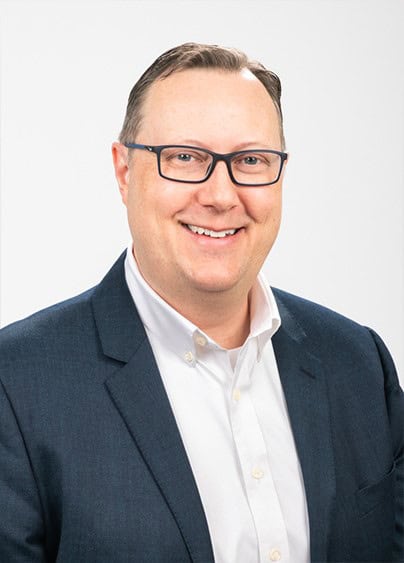Season 6: Episode #156
Podcast with Dwight Raum, EVP and Chief Digital Information Officer, Rochester Regional Health

Share
In this episode, Dwight Raum, EVP and Chief Digital Information Officer at Rochester Regional Health discusses his role at Rochester, organization’s digital landscape, generative AI initiatives, and efforts to optimize care delivery safely and efficiently.
Dwight highlights various initiatives and technologies being implemented at Rochester Regional Health, including the use of AI for call routing, and a digital front door that enhances web experiences and provides virtual care access within hours. He also talks about the creation of a Center of Excellence for AI and the role of AI in nurse scheduling.
Dwight emphasizes the importance of maintaining a human element in healthcare technology, expressing optimism about AI’s role in improving patient care. Take a listen!
Show Notes |
||||
| 01:14 | What interests you in the healthcare industry segment to become the CIO of a hospital system? | |||
| 02:47 | How long have you been in the leadership position at UMC, where is it located, and what kind of population does it serve? | |||
| 03:35 | You have done a lot of work from technology perspective to support the business needs of the hospital. You've done over 200 applications and transformed the EMR system. Would you like to share with the audience the thought process that drove those changes and what were some of those changes? | |||
| 07:47 | What do you think about your digital transformation efforts? If you could describe a few of them which have had impact on the patient population. | |||
| 08:30 | Please describe in your own, you know, way that what is digital transformation for provider systems such as yours? Where do you see it going? Some of the challenges that you might have faced and how did it actually end up impacting patients? | |||
| 11:24 | How did you manage to change the mindset of the people? How did they manage to change themselves? To adapt to this new world where technology, especially with AI and GenAI and other new technologies which are coming our way, how do you change mindsets and change behaviors and change culture over there? | |||
| 13:00 | Would you like to provide one example of how the technologies which you were implementing, and you continue to be implementing in your hospital system are accessible and usable by a variety of users, including within the hospital and outside the hospital. | |||
| 16:28 | How do you innovate? Do you involve external parties? Do you have some kind of a, you know, innovation focus department? Or is it part and parcel of everybody's, you know, kind of like daily life? | |||
| 19:24 | What are your thoughts on new technologies, especially Gen AI? Have you been experimenting with any predictive analytics or large language models? What would be your advice or thoughts to any other healthcare leaders on how to go about this journey of exploration? | |||
| 22:15 | Standing here now and looking back, if you were able to go back and change one or two things, what would you like to do differently or have done differently? | |||
Video Podcast and Extracts
About Our Guest

Dwight Raum is a healthcare technology executive with a successful career leading digital transformation initiatives in the industry. He is the former Chief Technology Officer (CTO) and interim Chief Information Officer (CIO) of Johns Hopkins Medicine (JHM) and the University. While there, Dwight led numerous strategic initiatives, including establishing the Technology Innovation Center, the Precision Medicine Analytics Platform, IT modernization, and cybersecurity efforts.
In 2021, Dwight left JHM to serve as the Chief Digital Officer at Quil Health, a healthcare technology startup that empowered seniors to stay in their homes longer through engagement daily insights. At Quil, he oversaw product development and engineering for the company's Assure product, where he implemented The Internet of Things(IoT) and artificial intelligence technology.
Dwight has written numerous articles on technology in healthcare and contributed to the thought leadership of digital transformation. He earned a degree in Management Science with a specialization in Operations Management from Virginia Tech.
Recent Episodes
Q. Hi Dwight, welcome to The Big Unlock podcast. My name is Ritu Uberoy, and I’m one of the co-hosts. We’re very happy — this is season six, and we’re glad to have you back. Delighted to hear new perspectives, especially on AI and your initiatives at your new organization. Let’s get started with your introduction and then dive into a few topics.
Dwight: Great. Really great to meet you and be here, Ritu. I’m Dwight Raum, Chief Digital Information Officer for Rochester Regional Health. We are a health system with about nine hospitals in Western and Northern New York. We span the spectrum from large, urban acute care hospitals to small, rural regional hospitals.
We also have a large ambulatory practice throughout the region, and we really take care of patients from birth to death — and every aspect of healthcare in between. I’ve been with the organization just over a year.
Before joining Rochester Regional Health, I was in the startup world for a short time. Prior to that, I served at Johns Hopkins Medicine as the Chief Technology Officer and Interim CIO. I’ve been in healthcare for quite a long time. I really came up as a technologist, which is increasingly unusual in senior IT leadership roles. But I’ve truly enjoyed my time in healthcare — the mission really calls to me.
Q. That’s a very interesting introduction, Dwight. It seems like you’ve seen all three aspects of technology and implementation — being at Johns Hopkins, which is a world-renowned teaching hospital, then moving to a startup, and now at Rochester. What was your role at the startup, and what did the startup do, before we get into your current role?
Dwight: Sure. It was technically a joint venture between Independence Blue Cross and Comcast. The startup was called Quil Health at the time. We were trying to build an in-home monitoring system that would allow seniors to age in place.
That consisted of various IoT sensors placed throughout the seniors’ homes. From those sensors, we ran AI models to anticipate and predict certain behaviors and patterns. Insights were drawn from the data and shared with caregivers.
It was a really interesting idea — just struggled to get it across the line, if you know what I mean. But I think it had tremendous potential. It actually speaks to the opportunities we have with signals and AI, and how that can really transform the way we provide care.
Q. Yeah, that’s very interesting. We had a webinar yesterday where we were presenting some case studies. One of the case studies we were going to present — but didn’t — was for Cherish Health. They do something very similar, radar-based. They have a device used in senior homes that can detect falls, go through walls, and anticipate events using AI.
Dwight: Yeah, I mean, the technology has evolved certainly over the last several years, and radar fall detection has really improved. But I still think there are a lot of challenges — in terms of privacy and getting over that technical hurdle for seniors to adopt and use the technology with trust.
Those are still barriers that aren’t easily overcome, even with the technology in place.
Q. Absolutely. Okay, great. So tell us a little more about your role at Rochester Regional Health — what the digital landscape is like there, your experience with generative AI, and some of the initiatives happening at your organization.
Dwight: Absolutely. As I mentioned, we’re a nine-hospital system. We’re mostly on one EMR — we’re an Epic shop, single instance. We do have some smaller EMRs, but we’re slowly but surely moving everything into a single instance.
In terms of initiatives, I’d group them into a couple of categories. The first is optimizing the system and the engine of care delivery we already have. That means ensuring throughput, doing so in a safe and high-quality manner, and providing access to our patients.
The second part is really transforming how we deliver care — shifting from a traditional fee-for-service model to a much more risk-based, value-based model. We’re focusing on treating patients for their outcomes instead of on a transactional basis.
That shift brings a lot of changes — not just in how technology works, but also in how our operators and clinicians provide care. It’s a transformational change for the system.
A lot of credit goes to our CEO, Dr. Chip Davis, who’s really leading that charge and planning for the future. When 2030 comes around and CMS starts to pay more earnestly based on value, I think we’re going to be very ready here in Northern New York to take on that challenge.
Q. In terms of the Clinical Access Center — is it a unified center? We recently worked with Sentara on a huge multi-year project where they brought everything into one place. Now they’ve implemented AI on top of that to handle call routing.
We did a webinar on their case study, and they shared something interesting — because of the AI they implemented in the call center, they can now predict when call volumes will be lower. That allows nurses to take flexible time off, which has been a big plus for them.
Dwight: I think that’s a great comparison for us. We do have a unified call center, and we are absolutely using AI for call routing and predicting high call volumes, etc. We’ve really been able to drive efficiency using AI in the call center.
Our call center is located right next to our command center, so we’re constantly looking at overall system operations — understanding volume, where to shift resources, where to move patients, and so on. Combining that with the call center is incredibly powerful.
Our call center isn’t just receiving calls — we’re also driving outbound traffic. And the third leg of the stool is that we’ve just rolled out a digital front door on our website — a robust digital experience for patients. It offers capabilities for patients to serve themselves, schedule appointments, and find the closest care options. We’re really trying to cover the full experience and serve patients as consumers as best we can.
Q. For the digital front door, do you have AI as well? Like virtual chatbots? How does that work?
Dwight: We’re not deploying chatbots in a very robust way at this point. Honestly, I’m not sure I see them as a strong tool for care delivery. There’s probably some limited front-door use for chatbots, but I don’t think they’re a great solution overall.
That said, our digital front door does provide access to direct virtual care. Patients can usually get an appointment within an hour or less — they’re able to see a provider almost right away. So it’s really about combining access with technology to deliver care where patients are, in almost real time.
Q. So. Sentara mentioned they use something called Edia for the AI part of their call center. Do you know which AI implementation you’re using?
Dwight: Yeah, we’re a customer, and there are embedded AI tools within Genesys — that’s what we’re using.
Q. So, how big is the technology component at Rochester Regional? And do you see a role for a Chief AI Officer? That’s a hot topic these days — ethics, governance committees, Chief AI Officer roles. Would love to hear your thoughts.
Dwight: That’s a broad question — let me take a shot at it. In total, we’re about 400 people in our IT organization. I might have had a bit of a Freudian slip earlier — I’m very much trying to reorient the organization to think about AI, but more broadly, innovation.
So, how do we bring technology and new ways of thinking to transform the tools and experiences we deliver?
To your specific question — do I anticipate us having a Chief AI Officer? The simple answer is no. I don’t think that makes a lot of sense, quite frankly.
What we have done is create a Center of Excellence for AI. It’s a group of the right people who need to be at the table to do two things. First, there’s the “pull” — a lot of demand from our operators who see new tools and ask, “Hey, can I get this?” We need to be thoughtful about privacy, contracts, ethics — all the right teams are part of the COE to address those questions and respond responsibly to that pull.
But there’s also the “push.” AI has been evolving at an incredible pace — even in just the last 6 to 18 months. It’s impossible for any one person, or even our providers, to keep up with it all. So the second part of our AI COE’s responsibility is to articulate what’s possible — the art of the possible.
We’re maintaining an initiative list of opportunities we think are ripe for AI — places where we can deploy capabilities, whether it’s LLMs or machine learning, to have an immediate or significant impact.
Q. And for all your AI implementations, are you planning to stay within Epic, since they’re building their own AI tools? Or are you looking to integrate outside solutions too?
Dwight: I think we’ll always look at what we already own first. Epic is a chassis in many ways — we can plug in different Epic modules and activate them. So yes, we’ll definitely start there.
But that doesn’t mean we’ll only look there. As I mentioned earlier, Genesys offers incredible AI capabilities — that’s an example of something outside of Epic but still integrated into our environment.
So no, this isn’t going to be an Epic-only play. But there are definitely some low-hanging opportunities within Epic that we’ll evaluate, ensure they provide value, and then activate them for our providers.
Q. Okay. I’m just mulling over your answer because other CIOs and CTOs we’ve been talking to feel the need for a Chief AI Officer, for the same reasons you mentioned—trust, governance, and the pace of change. It’s difficult for one person to keep up. Some believe you need a dedicated person whose job is to look at that landscape, understand what’s happening, and decide what’s best for the company. Just playing devil’s advocate here, trying to look at both sides.
Dwight: My reaction is, if we were in the business of developing AI ourselves, I would agree. But we’re not. We’re a system focused on serving our patients. Our priority is patient care, and we’ll use AI to support that. I do think it requires a collection of experts. From legal, privacy, and algorithmic safety standpoints—maybe a Chief AI Officer could be the lightning rod that brings that all together.
But honestly, we’ve come up with a methodology that works well for us in the COE. It allows us to bring together those experts and, more importantly, align their interests. Even if you have a Chief AI Officer, they still have to orchestrate all the soft power and influence that drive real change. In my view, the AI COE approach forces that to happen from the start.
Q. Yeah, that’s a very astute observation. That’s exactly what we’ve learned in our webinars—it can’t be mandated; everyone has to buy into it. It’s a behavioral change, especially with these new tools coming in.
The other point of view I have, which came up in a webinar yesterday, is that the EU has passed a law mandating AI training for any company using AI. What do you think about the training landscape? Are all your employees getting AI training?
Dwight: No, we haven’t mandated broad-based AI training yet. That’s likely to happen depending on the tools we’re using. We talk about it a lot as leadership. As we approach deployment of smart ML models for diagnosis or therapies, there will be very targeted and intensive training around each one.
Q. So as of now, people just learn on their own? Both—like LLMs or ML tools.
Dwight: So, as I said, I’ve personally hosted several webinars across the organization to provide baseline information about how tools work. But we’re not yet offering formalized training. The challenge is that healthcare is very busy and, in many ways, understaffed. Capacity is a real concern. We have to be cautious and ensure training is impactful.
My sense is that as opportunities become more acute, and we identify specific use cases, we’ll do more. We’ve also deployed an AI policy that specifies what is considered safe use for generative AI.
Q. In your hospital environment, do you have people using ChatGPT and possibly uploading data without realizing it could become public or used to train the model?
Dwight: That’s been part of our internal communications campaign—clarifying what’s appropriate. It’s hard to police, and I can’t say for certain it hasn’t happened. But we’ve provided guidance and education. A lot of people don’t realize that unless you opt out, anything you type can be used to train the model.
Q. Exactly. Okay, great. So, Dwight, talking to multiple CIOs and CTOs, the main generative AI success stories we’re hearing fall into two categories: scribing and ambient. What’s your experience with either, and do you have a success story?
Dwight: Honestly, we’re a little late to the game. We’ve just started our pilot for Ambient Digital Scribe. We’ve done early testing, and it’s clearly a win for providers. It helps reduce pajama time and after-hours documentation. But these tools are also incredibly expensive, so we’re evaluating ROI—how to unburden providers while sustaining the investment financially.
Q. Yeah, very interesting. At HIMSS last year, Nuance shared that ambient tools save about six minutes per patient. That doesn’t sound like a lot, but across multiple physicians and patients, it adds up quickly.
Dwight: Absolutely. Over the last 15 years, digitizing healthcare hasn’t been seen as a net plus by most providers. It’s negatively impacted their quality of work. COVID contributed to burnout, but so has technology fatigue. Any opportunity to unburden providers using tech—we should seize it.
Q. Good to know you’re in the early stages and testing. Any other digital programs you’d like to highlight?
Dwight: Yeah, I think, you know, there are several that I would highlight, and I would kind of back it up to a higher level for us. As I mentioned earlier, Chip, our CEO, has really been very much driving transformation. But I think a supporting function there is really innovation writ large, and AI fits into that innovation model as well.
So we’ve really begun to create an entire innovation program for all of RH, where we have two parts to that program. The first is focused on internal performance improvement—transformation and innovation. And then we’re coupling that with an accelerator program to actually take some of those innovations to market, and also to partner with other startups to bring them back into RH.
We’re doing this in a very prescriptive and deliberate way, ensuring it’s aligned with our strategy. So, where we have opportunities or challenges, we’re trying to line up those companies that may actually fit and help us solve some of those niche problems. I’ll give you a really good example of this.
Healthcare is currently experiencing a drop-off in employees, and there’s certainly a challenge in maintaining staffing. Nurses, I think, are the most acute area where we see that. But we’re also in this perfect storm where demand is increasing at a remarkable rate. So that gap between supply and demand—the only reasonable way to think about closing that gap is through technologies.
As you mentioned, AI—and we talked about Abridge as a digital scribe—as one way of doing that. But there are certainly other opportunities in that space. Just scheduling nurses, for instance, is incredibly burdensome right now and leads to tremendous inefficiency. Every little point of improvement we get there pays multiples in dividends.
So as we look at opportunities, a good example is nurse scheduling—can we apply AI to actually improve the speed and efficiency of that process? And the answer is yes. That’s a great example of a strategically aligned innovation opportunity that we’re actively pursuing at RH.
And I can stack up numerous examples like that. We talked about the digital front door and trying to improve access by casting a broad digital net, but also empowering our patients with tools to self-serve and gain access to care as quickly as possible.
It’s those types of activities that we see as the through line from the innovation continuum I was talking about earlier. So while an innovation may start by solving a very acute problem within RH, we believe we can develop those ideas into something that scales across the entire organization—and potentially even goes to market more broadly.
Q. That’s really interesting. The accelerator program—does it include in-house participation too?
Dwight: It does. A great example is a physician in emergency medicine who developed an app called COIST. It’s a heads-up display on an iPad that guides cardiac resuscitation based on ACLS guidelines and documents the process in real-time. We helped develop it, and it’s a great example of internal innovation with life-saving potential. It also eases the provider’s burden in emergency care—and it’s not a problem unique to RH. We believe it has wider potential.
Q. Yeah. So they’ve seen really good success with longitudinal care plans and generating care plans—still with the human in the loop to make the final call.
Dwight: I think especially with LLMs, that’s critical. I don’t see that changing anytime soon. One of my personal hobbies is coding, and I use LLMs all the time. It’s remarkable how good they are, but also remarkable how they hallucinate—just make things up. So I think there’s a definite need for caution and keeping a human in the loop.
That’s why I think RAG implementations have seen greater success—because you can bound them, put guardrails in place, and ground them in truth.
Q. Any challenges you’d like to talk about? What do you feel is your biggest challenge with technology?
Dwight: Yeah, I mean, I think, you know, the financial pressures in healthcare are certainly still very acute. And I think, in a lot of ways, that’s the oxygen you need to really drive wholesale innovation and transformation. So that’s certainly a challenge.
I think cybersecurity is also something that continues to be a top-of-mind concern for any CIO these days. And, for that matter, the accompanying investments you have to make to really tighten things up, so to speak. Mm-hmm.
Those are the challenges I see. And there are challenges around workforce, too—maintaining a team that can really drive and advance the ball is very critical as well.
By and large, I’m an optimist by nature—and a technologist by nature. I actually think there is real opportunity. If you take a step back and look at that gap I was talking about earlier—around supply and demand—and, for that matter, how much we spend as a country on healthcare, I do think there’s good reason to be optimistic about the future and how technology can play a really important role in helping us, as a society, meet the demand of healthcare and actually improve people’s lives.
We hope you enjoyed this podcast. Subscribe to our podcast series at www.thebigunlock.com and write to us at [email protected]
Disclaimer: This Q&A has been derived from the podcast transcript and has been edited for readability and clarity.
About the host
Paddy is the co-author of Healthcare Digital Transformation – How Consumerism, Technology and Pandemic are Accelerating the Future (Taylor & Francis, Aug 2020), along with Edward W. Marx. Paddy is also the author of the best-selling book The Big Unlock – Harnessing Data and Growing Digital Health Businesses in a Value-based Care Era (Archway Publishing, 2017). He is the host of the highly subscribed The Big Unlock podcast on digital transformation in healthcare featuring C-level executives from the healthcare and technology sectors. He is widely published and has a by-lined column in CIO Magazine and other respected industry publications.

Ritu M. Uberoy has over twenty-five years of experience in the software and information technology industry in the United States and in India. She established Saviance Technologies in India and has been involved in the delivery of several successful software projects and products to clients in various industry segments.
Ritu completed AI for Health Care: Concepts and Applications from the Harvard T.H. Chan School of Public Health and Applied Generative AI for Digital Transformation from MIT Professional Education. She has successfully taught Gen AI concepts in a classroom setting in Houston and in workshop settings to C-Suite leaders in Boston and Cleveland. She attended HIMSS in March 2024 at Orlando and the Imagination in Action AI Summit at MIT in April 2024. She is also responsible for the GenAI Center of Excellence at BigRio and DigiMTM Digital Maturity Model and Assessment at Damo.
Ritu earned her Bachelor’s degree in Computer Science from Delhi Institute of Technology (now NSIT) and a Master’s degree in Computer Science from Santa Clara University in California. She has participated in the Fellow’s program at The Wharton School, University of Pennsylvania.

Rohit Mahajan is an entrepreneur and a leader in the information technology and software industry. His focus lies in the field of artificial intelligence and digital transformation. He has also written a book on Quantum Care, A Deep Dive into AI for Health Delivery and Research that has been published and has been trending #1 in several categories on Amazon.
Rohit is skilled in business and IT strategy, M&A, Sales & Marketing and Global Delivery. He holds a bachelor’s degree in Electronics and Communications Engineering, is a Wharton School Fellow and a graduate from the Harvard Business School.
Rohit is the CEO of Damo, Managing Partner and CEO of BigRio, the President at Citadel Discovery, Advisor at CarTwin, Managing Partner at C2R Tech, and Founder at BetterLungs. He has previously also worked with IBM and Wipro. He completed his executive education programs in AI in Business and Healthcare from MIT Sloan, MIT CSAIL and Harvard School of Public Health. He has completed the Global Healthcare Leaders Program from Harvard Medical School.

Paddy was the co-author of Healthcare Digital Transformation – How Consumerism, Technology and Pandemic are Accelerating the Future (Taylor & Francis, Aug 2020), along with Edward W. Marx. Paddy was also the author of the best-selling book The Big Unlock – Harnessing Data and Growing Digital Health Businesses in a Value-based Care Era (Archway Publishing, 2017). He was the host of the highly subscribed The Big Unlock podcast on digital transformation in healthcare featuring C-level executives from the healthcare and technology sectors. He was widely published and had a by-lined column in CIO Magazine and other respected industry publications.
Stay informed on the latest in digital health innovation and digital transformation